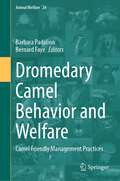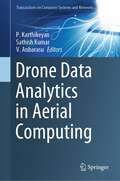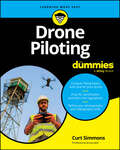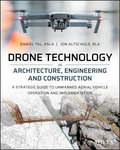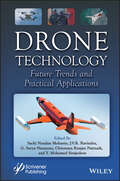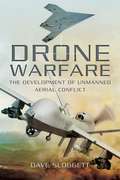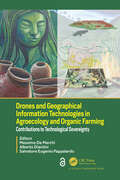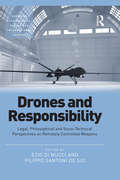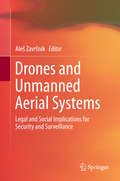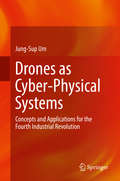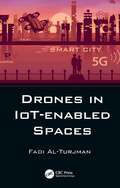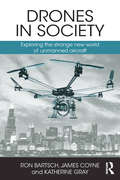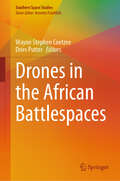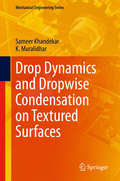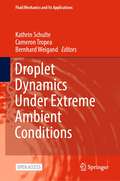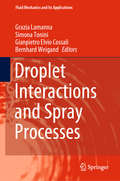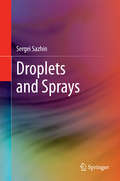- Table View
- List View
Droidmaker: George Lucas and the Digital Revolution
by Michael RubinThe inside story of George Lucas, his intensely private company, and their work to revolutionize filmmaking. In the process, they made computer history. Discover the birth of Pixar, digital video editing, videogame avitars, THX sound, and a host of other icons of the media age. Lucas played a central role in the universe of entertainment technologies we see everyday.
Dromedary Camel Behavior and Welfare: Camel Friendly Management Practices (Animal Welfare #24)
by Bernard Faye Barbara PadalinoThis volume gives a comprehensive review on dromedary camel handling and management by respecting its welfare, which is a global first. Beyond that, it provides a new welfare assessment tool.Expert authors lay the groundwork for understanding the animals by covering domestication, camels´ behavioral repertoire and needs, as well as dromedary camel genetics and coping with production systems. Then, the reader is equipped with the latest expertise on good management practices in camel farms, including transport, feeding, housing from racing to dairy systems, and health and hygiene. Moreover, the impact of innovative reproduction techniques and, finally, slaughter are taken into account.Camels, long confined to desert areas and kept extensively, have recently faced changes in husbandry systems and their environment. Intensification and specialization for milk, meat or sport purpose, as well as new geographic conditions have had significant impact on camel welfare.This book is a must-read for all camel industry members, breeders, veterinarians, and researchers, who want to practice camel breeding and management while safeguarding the behavioral needs and welfare of these amazing animals.
Drone Art: The Everywhere War as Medium
by Thomas StubblefieldWhat happens when a drone enters a gallery or appears on screen? What thresholds are crossed as this weapon of war occupies everyday visual culture? These questions have appeared with increasing regularity since the advent of the War on Terror, when drones began migrating into civilian platforms of film, photography, installation, sculpture, performance art, and theater. In this groundbreaking study, Thomas Stubblefield attempts not only to define the emerging genre of "drone art" but to outline its primary features, identify its historical lineages, and assess its political aspirations. Richly detailed and politically salient, this book is the first comprehensive analysis of the intersections between drones, art, technology, and power.
Drone Data Analytics in Aerial Computing (Transactions on Computer Systems and Networks)
by P. Karthikeyan Sathish Kumar V. AnbarasuThis book discusses the latest research, theoretical, and experimental research innovations in drone data analytics in aerial computing. Drone data analytics guarantees that the right people have the correct data at their fingertips whenever they need it. The contents also discuss the challenges faced with drone data analytics, such as due to the high mobility of drones, aerial computing is significantly different from terrestrial computing. It also includes case studies from leading drone vendors. The book also focuses on the comparison of data management and security mechanisms in drone data analytics. This book is useful to those working in agriculture, mining, waste management, and defenses department.
Drone Piloting For Dummies
by Curt SimmonsThe know-how you need to become a pro drone pilot and market your skill Licensed and skilled drone pilots are in huge demand. Drone Piloting For Dummies teaches you how to make a career out of it. From real estate to construction to inspection to mapping to delivery, the need for drone photography and videography is everywhere. This book outlines the basics of selecting and operating a drone, shows you how to get licensed, and explains all the regulations you need to know. You'll also learn to read charts and capture high-quality photos and videos. Plus, this guide walks you through the process of turning this skill into a full-time career or profitable side hustle. Written by a licensed drone pilot and entrepreneur, Drone Piloting For Dummies helps you take off on your new adventure! Grasp flying basics and care for your drone Prep for certification and learn the regulations Refine your photography and videography skills Market your skills and discover cool career opportunities This book is for anyone who wants to become a drone pilot or increase their piloting skills for job readiness and performance.
Drone Technology in Architecture, Engineering and Construction: A Strategic Guide to Unmanned Aerial Vehicle Operation and Implementation
by Daniel Tal John AltschuldA start-to-finish roadmap on incorporating drone technology into your AEC firm workflow Drone Technology in Architecture, Engineering and Construction: A Strategic Guide to Unmanned Aerial Vehicle Operation and Implementation is the only process-driven, step-by-step handbook to implement drone technology in AEC workflows. It provides a comprehensive and practical roadmap for architecture, engineering, and construction firms to incorporate drones into their design and construction processes. The book offers extensive information on drone data processing, and includes guidance on how to acquire, manipulate and use the various data types produced from drone flights. The creation of three-dimensional data and visualizations are covered in-depth. Drone Technology reviews how to select and fly drones based on data needs and initial costs, and how to collect and maintain required flight logs, licenses, and permits. Drone Technology uses several real-world project examples that demonstrate and explain how drones can be used to collect: · Full-color orthorectified imagery · Accurate 3D point cloud and mesh models · Topographic contours · Digital Elevation Models (DEMs) The project examples also describe how these datasets can be integrated with 3D models of proposed conditions, photos, and other project datasets. Drone Technology in Architecture, Engineering and Construction is an essential guide for a wide variety of professionals, from civil engineers to landscape architects. It provides information on professional use of drones for those just considering the technology, to those already flying drones professionally. It is an invaluable guide for anyone working in the design or construction of buildings and landscapes.
Drone Technology: Future Trends and Practical Applications
by Sachi Nandan Mohanty G. Surya Narayana Chinmaya Ranjan Pattnaik Y. Mohamed Sirajudeen J.V.R. RavindraDRONE TECHNOLOGY This book provides a holistic and valuable insight into the revolutionary world of unmanned aerial vehicles (UAV). The book elucidates the revolutionary and riveting research in the ultramodern domain of drone technologies, drone-enabled IoT applications, and artificial intelligence-based smart surveillance. The book explains the most recent developments in the field, challenges, and future scope of drone technologies. Beyond that, it discusses the importance of a wide range of design applications, drone/UAV development, and drone-enabled smart healthcare systems for smart cities. It describes pioneering work on mitigating cyber security threats by employing intelligent machine learning models in the designing of IoT-aided drones. The book also has a fascinating chapter on application intrusion detection by drones using recurrent neural networks. Other chapters address interdisciplinary fields like artificial intelligence, deep learning, the role of drones in healthcare in smart cities, and the importance of drone technology in agriculture. Audience The book will be read and consulted by a range of industry engineers involved with introducing drone technology to their daily operations.
Drone Warfare: The Development of Unmanned Aerial Conflict
by Dave SloggettAn unmanned aerial vehicle, commonly known as a drone, is an aircraft without a human pilot on board. Its flight is either controlled autonomously by computers in the vehicle, or under the remote control of a navigator or pilot on the ground or in another vehicle. Drone Warfare is one of the first books to examine the development and use of such aerial drones. Drones have been much maligned in the media and popular culture and there has been much controversy over their deployment. This book reveals the history of unmanned aircraft, their recent development, and why they have emerged onto the scene, setting the record straight about drones and their use. Drone Warfare answers questions such as: Why did the United States invest so highly drone technology? When did all that start? What barriers had to be overcome? What was there before drones arrived? What roles did drones play in Iraq and Afghanistan? Were they successful? What new developments emerged during operations? Did they save lives? How many have been shot down and where? Will all air forces be drone based in the future? What other applications may arise in the civilian market? In a timely publication, Drone Warfare sets the record straight on unmanned aerial vehicles and explores technology and usage around the globe. Skyhorse Publishing, as well as our Arcade imprint, are proud to publish a broad range of books for readers interested in history--books about World War II, the Third Reich, Hitler and his henchmen, the JFK assassination, conspiracies, the American Civil War, the American Revolution, gladiators, Vikings, ancient Rome, medieval times, the old West, and much more. While not every title we publish becomes a New York Times bestseller or a national bestseller, we are committed to books on subjects that are sometimes overlooked and to authors whose work might not otherwise find a home.
Drone Wars
by Peter L. Bergen Daniel RothenbergDrones are the iconic military technology of many of today's most pressing conflicts. Drones have captured the public imagination, partly because they project lethal force in a manner that challenges accepted norms and moral understandings. Drone Wars presents a series of essays by legal scholars, journalists, government officials, military analysts, social scientists, and foreign policy experts. It addresses drones' impact on the ground, how their use adheres to and challenges the laws of war, their relationship to complex policy challenges, and the ways they help us understand the future of war. The book is a diverse and comprehensive interdisciplinary perspective on drones that covers important debates on targeted killing and civilian casualties, presents key data on drone deployment, and offers new ideas on their historical development, significance, and impact on law and policy.
Drone: Remote Control Warfare
by Hugh GustersonDrones are changing the conduct of war. Deployed at presidential discretion, they can be used in regular war zones or to kill people in such countries as Yemen and Somalia, where the United States is not officially at war. Advocates say that drones are more precise than conventional bombers, allowing warfare with minimal civilian deaths while keeping American pilots out of harm's way. Critics say that drones are cowardly and that they often kill innocent civilians while terrorizing entire villages on the ground. In this book, Hugh Gusterson explores the significance of drone warfare from multiple perspectives, drawing on accounts by drone operators, victims of drone attacks, anti-drone activists, human rights activists, international lawyers, journalists, military thinkers, and academic experts. Gusterson examines the way drone warfare has created commuter warriors and redefined the space of the battlefield. He looks at the paradoxical mix of closeness and distance involved in remote killing: is it easier than killing someone on the physical battlefield if you have to watch onscreen? He suggests a new way of understanding the debate over civilian casualties of drone attacks. He maps "ethical slippage" over time in the Obama administration's targeting practices. And he contrasts Obama administration officials' legal justification of drone attacks with arguments by international lawyers and NGOs.
Drone: Remote Control Warfare
by Hugh GustersonDrone warfare described from the perspectives of drone operators, victims of drone attacks, anti-drone activists, international law, military thinkers, and others. Drones are changing the conduct of war. Deployed at presidential discretion, they can be used in regular war zones or to kill people in such countries as Yemen and Somalia, where the United States is not officially at war. Advocates say that drones are more precise than conventional bombers, allowing warfare with minimal civilian deaths while keeping American pilots out of harm's way. Critics say that drones are cowardly and that they often kill innocent civilians while terrorizing entire villages on the ground. In this book, Hugh Gusterson explores the significance of drone warfare from multiple perspectives, drawing on accounts by drone operators, victims of drone attacks, anti-drone activists, human rights activists, international lawyers, journalists, military thinkers, and academic experts.Gusterson examines the way drone warfare has created commuter warriors and redefined the space of the battlefield. He looks at the paradoxical mix of closeness and distance involved in remote killing: is it easier than killing someone on the physical battlefield if you have to watch onscreen? He suggests a new way of understanding the debate over civilian casualties of drone attacks. He maps “ethical slippage” over time in the Obama administration's targeting practices. And he contrasts Obama administration officials' legal justification of drone attacks with arguments by international lawyers and NGOs.
Drones and Geographical Information Technologies in Agroecology and Organic Farming: Contributions to Technological Sovereignty
by Massimo De MarchiAlthough organic farming and agroecology are normally not associated with the use of new technologies, it’s rapid growth, new technologies are being adopted to mitigate environmental impacts of intensive production implemented with external material and energy inputs. GPS, satellite images, GIS, drones, help conventional farming in precision supply of water, pesticides, fertilizers. Prescription maps define the right place and moment for interventions of machinery fleets. Yield goal remains the key objective, integrating a more efficient use or resources toward an economic-environmental sustainability. Technological smart farming allows extractive agriculture entering the sustainability era. Societies that practice agroecology through the development of human-environmental co-evolutionary systems represent a solid model of sustainability. These systems are characterized by high-quality agroecosystems and landscapes, social inclusion, and viable economies. This book explores the challenges posed by the new geographic information technologies in agroecology and organic farming. It discusses the differences among technology-laden conventional farming systems and the role of technologies in strengthening the potential of agroecology. The first part reviews the new tools offered by geographic information technologies to farmers and people. The second part provides case studies of most promising application of technologies in organic farming and agroecology: the diffusion of hyperspectral imagery, the role of positioning systems, the integration of drones with satellite imagery. The third part of the book, explores the role of agroecology using a multiscale approach from the farm to the landscape level. This section explores the potential of Geodesign in promoting alliances between farmers and people, and strengthening food networks, whether through proximity urban farming or asserting land rights in remote areas in the spirit of agroecological transition. The Open Access version of this book, available at www.taylorfrancis.com, has been made available under a Creative Commons 4.0 license.
Drones and Responsibility: Legal, Philosophical and Socio-Technical Perspectives on Remotely Controlled Weapons (Emerging Technologies, Ethics and International Affairs)
by Ezio Di Nucci Filippo Santoni SioHow does the use of military drones affect the legal, political, and moral responsibility of different actors involved in their deployment and design? This volume offers a fresh contribution to the ethics of drone warfare by providing, for the first time, a systematic interdisciplinary discussion of different responsibility issues raised by military drones. The book discusses four main sets of questions: First, from a legal point of view, we analyse the ways in which the use of drones makes the attribution of criminal responsibility to individuals for war crimes more complicated and what adjustments may be required in international criminal law and in military practices to avoid ’responsibility gaps’ in warfare. From a moral and political perspective, the volume looks at the conditions under which the use of military drones by states is impermissible, permissible, or even obligatory and what the responsibilities of a state in the use of drones towards both its citizens and potential targets are. From a socio-technical perspective, what kind of new human machine interaction might (and should) drones bring and which new kinds of shared agency and responsibility? Finally, we ask how the use of drones changes our conception of agency and responsibility. The book will be of interest to scholars and students in (military) ethics and to those in law, politics and the military involved in the design, deployment and evaluation of military drones.
Drones and Support for the Use of Force
by Marcus Schulzke James Igoe WalshCombat drones are transforming attitudes about the use of military force. Military casualties and the costs of conflict sap public support for war and for political and military leaders. Combat drones offer an unprecedented ability to reduce these costs by increasing accuracy, reducing the risks to civilians, and protecting military personnel from harm. These advantages should make drone strikes more popular than operations involving ground troops. Yet many critics believe drone warfare will make political leaders too willing to authorize wars, weakening constraints on the use of force. Because combat drones are relatively new, these arguments have been based on anecdotes, a handful of public opinion polls, or theoretical speculation. Drones and Support for the Use of Force uses experimental research to analyze the effects of combat drones on Americans’ support for the use of force. The authors’ findings—that drones have had important but nuanced effects on support for the use of force—have implications for democratic control of military action and civil-military relations and provide insight into how the proliferation of military technologies influences foreign policy.
Drones and Unmanned Aerial Systems
by Aleš ZavršnikThis book tackles the regulatory issues of Unmanned Aerial Systems (UAS) or Remotely-Piloted Aerial Systems (RPAS), which have profound consequences for privacy, security and other fundamental liberties. Collectively known as "drones," they were initially deployed for military purposes: reconnaissance, surveillance and extrajudicial executions. Today, we are witnessing a growth of their use into the civilian and humanitarian domain. They are increasingly used for goals as diverse as news gathering, aerial inspection of oil refinery flare stacks, mapping of the Amazonian rain-forest, crop spraying and search and rescue operations. The civil use of drones is becoming a reality in the European Union and in the US. The drone revolution may be a new technological revolution. Proliferation of the next generation of "recreational" drones show how drones will be sold as any other consumer item. The cultural perception of the technology is shifting, as drones are increasingly being used for humanitarian activities, on one hand, but they can also firmly be situated in the prevailing modes of postmodern governance on the other hand. This work will be of interest to researchers in Criminology and Criminal Justice interested in issues related to surveillance, security, privacy, and technology. It will also provide a criminological background for related legal issues, such as privacy law, aviation law, international criminal law, and comparative law.
Drones as Cyber-Physical Systems: Concepts And Applications For The 4th Industrial Revolution
by Jung-Sup UmThis book introduces the concept of using drones as a teaching tool to explore the fundamental principles, technology and applications of Cyber-Physical Systems (CPS). A short introduction sets CPS in the context of the 4th industrial revolution, and describes various CPS technologies including self-driving cars, commercial intelligent drones and mobile robots, in which artificial intelligence routinely supports smarter decision-making. The core of the book then focuses on commercially available drones, the only available system offering the advantage of cyber-physical bridging through 3D autonomous dynamic flying in classroom conditions. Chapters describe drone technology, including location sensors and imaging systems. CPS theory is explained through typical drone flying procedures and do-it-yourself (DIY) aerial photography in which communication between sensors, actuators and controllers occurs through cyber-physical bi-directional bridging. This book opens new possibilities in fostering 4th industrial revolution literacy, introducing relevant examples from readily available equipment, making core elements of cyber-physical bridging accessible. It is aimed primarily at those students who have an interest in CPS, drones and those from disciplines that are concerned with spatial information.
Drones in IoT-enabled Spaces
by Fadi Al-TurjmanThe Internet of Things (IoT) is a system of inter-connected devices, objects, and organisms. Among these devices, drones are gaining lots of interest. Drones are expected to communicate with cellular networks in the next generation networks (5G and beyond) which opens the door for another exciting research area. This book considers very important research areas in drone and cellular networks. It addresses major issues and challenges in drone-based solutions proposed for IoT-enabled cellular/computer networks, routing/communication protocols, surveillances applications, secured data management, and positioning approaches. It focuses mainly on smart and context-aware implementations.
Drones in Society: Exploring the strange new world of unmanned aircraft
by Ron Bartsch James Coyne Katherine GrayThe integration of drones into society has attracted unprecedented attention throughout the world. The change, for aviation, has been described as being equally as big as the arrival of the jet engine. This book examines the issues that surround this change, for our society and the legal frameworks that preserve our way of life. Drones in Society takes the uninitiated on a journey to understand the history of drones, the present day and the potential future in order to demystify the media hype. Written in an accessible style, Drones in Society will appeal to a broad range of interested readerships, among them students, safety regulators, government employees, airspace regulators, insurance brokers and underwriters, risk managers, lawyers, privacy groups and the Remotely Piloted Aircraft System (RPAS) industry generally. In a world first, this book is a light and interesting read; being both relatable and memorable while discussing complex matters of privacy, international law and the challenges ahead for us all.
Drones in the African Battlespaces (Southern Space Studies)
by Wayne Stephen Coetzee Dries PutterThis book, a collaborative endeavour by experts from various disciplines, meticulously investigates the increasing reliance on drones in conflicts across Africa, delving into their geopolitical, tactical, and ethical ramifications. By emphasising African perspectives, it examines the distinct dynamics of the region, highlighting the interactions between state actors, non-state actors, and external powers. The contributions explore the proliferation of armed and unarmed drones and their deployment by violent non-state actors alongside the rise of indigenous drone manufacturing. Topics include counterterrorism, sovereignty, and regional stability. The analysis is enriched with in-depth case studies, offering a nuanced understanding of the tactical, operational, and strategic implications of drones in African battlespaces. The book underscores the potential of drones to address Africa's unique security challenges, such as irregular warfare and porous borders, while also raising ethical concerns related to surveillance, civilian casualties, and dual-use technologies. Drones in the African battlespaces provide a timely, comprehensive examination of how unmanned systems are reshaping warfare and security across the continent, inviting policymakers, researchers, and practitioners to critically engage with the implications of this technological shift for Africa&’s future.
Drop Dynamics and Dropwise Condensation on Textured Surfaces (Mechanical Engineering Series)
by Sameer Khandekar K. MuralidharThis book is an expanded form of the monograph, Dropwise Condensation on Inclined Textured Surfaces, Springer, 2013, published earlier by the authors, wherein a mathematical model for dropwise condensation of pure vapor over inclined textured surfaces was presented, followed by simulations and comparison with experiments. The model factored in several details of the overall quasi-cyclic process but approximated those at the scale of individual drops. In the last five years, drop level dynamics over hydrophobic surfaces have been extensively studied. These results can now be incorporated in the dropwise condensation model.Dropwise condensation is an efficient route to heat transfer and is often encountered in major power generation applications. Drops are also formed during condensation in distillation devices that work with diverse fluids ranging from water to liquid metals. Design of such equipment requires careful understanding of the condensation cycle, starting from the birth of nuclei, followed by molecular clusters, direct growth of droplets, their coalescence, all the way to instability and fall-off of condensed drops. The model described here considers these individual steps of the condensation cycle. Additional discussions include drop shape determination under static conditions, a fundamental study of drop spreading in sessile and pendant configurations, and the details of the drop coalescence phenomena. These are subsequently incorporated in the condensation model and their consequences are examined. As the mathematical model is spread over multiple scales of length and time, a parallelization approach to simulation is presented. Special topics include three-phase contact line modeling, surface preparation techniques, fundamentals of evaporation and evaporation rates of a single liquid drop, and measurement of heat transfer coefficient during large-scale condensation of water vapor. We hope that this significantly expanded text meets the expectations of design engineers, analysts, and researchers working in areas related to phase-change phenomena and heat transfer.
Drop Heating and Evaporation: Analytical Solutions in Curvilinear Coordinate Systems (Mathematical Engineering)
by Simona Tonini Gianpietro Elvio CossaliThis book describes analytical methods for modelling drop evaporation, providing the mathematical tools needed in order to generalise transport and constitutive equations and to find analytical solutions in curvilinear coordinate systems. Transport phenomena in gas mixtures are treated in considerable detail, and the basics of differential geometry are introduced in order to describe interface-related transport phenomena. One chapter is solely devoted to the description of sixteen different orthogonal curvilinear coordinate systems, reporting explicitly on the forms of their differential operators (gradient, divergent, curl, Laplacian) and transformation matrices. The book is intended to guide the reader from mathematics, to physical descriptions, and ultimately to engineering applications, in order to demonstrate the effectiveness of applied mathematics when properly adapted to the real world. Though the book primarily addresses the needs of engineering researchers, it will also benefit graduate students.
Drop by Drop: Book One Step By Step (Step by Step #1)
by Morgan LlywelynFrom Morgan Llywelyn, the bestselling author of Lion of Ireland and the Irish Century series, comes Drop By Drop her first near-future science fiction thrillerUnbound Worlds—The Best Sci Fi and Fantasy Books of June 2018 In this first book in the Step By Step trilogy, global catastrophe occurs as all plastic mysteriously liquefies. All the small components making many technologies possible—navigation systems, communications, medical equipment—fail. In Sycamore River, citizens find their lives disrupted as everything they've depended on melts around them, with sometimes fatal results. All they can rely upon is themselves.And this is only the beginning . . .At the Publisher's request, this title is being sold without Digital Rights Management Software (DRM) applied.
Droplet Dynamics Under Extreme Ambient Conditions (Fluid Mechanics and Its Applications #124)
by Cameron Tropea Bernhard Weigand Kathrin SchulteThis open access book presents the main results of the Collaborative Research Center SFB-TRR 75, which spanned the period from 2010 to 2022. Scientists from a variety of disciplines, ranging from thermodynamics, fluid mechanics, and electrical engineering to chemistry, mathematics, computer science, and visualization, worked together toward the overarching goal of SFB-TRR 75, to gain a deep physical understanding of fundamental droplet processes, especially those that occur under extreme ambient conditions. These are, for example, near critical thermodynamic conditions, processes at very low temperatures, under the influence of strong electric fields, or in situations with extreme gradients of boundary conditions. The fundamental understanding is a prerequisite for the prediction and optimisation of engineering systems with droplets and sprays, as well as for the prediction of droplet-related phenomena in nature. The book includes results from experimental investigations as well as new analytical and numerical descriptions on different spatial and temporal scales. The contents of the book have been organised according to methodological fundamentals, phenomena associated with free single drops, drop clusters and sprays, and drop and spray phenomena involving wall interactions.
Droplet Interactions and Spray Processes (Fluid Mechanics and Its Applications #121)
by Bernhard Weigand Grazia Lamanna Simona Tonini Gianpietro Elvio CossaliThis book provides a selection of contributions to the DIPSI workshop 2019 (Droplet Impact Phenomena & Spray Investigations) as well as recent progress of the Int. Research Training Group “DROPIT”.The DIPSI workshop, which is now at its thirteenth edition, represents an important opportunity to share recent knowledge on droplets and sprays in a variety of research fields and industrial applications. The research training group “DROPIT” is focused on droplet interaction technologies where microscopic effects influence strongly macroscopic behavior. This requires the inclusion of interface kinetics and/or a detailed analysis of surface microstructures. Normally, complicated technical processes cover the underlying basic mechanisms, and therefore, progress in the overall process modelling can hardly be gained. Therefore, DROPIT focuses on the underlying basic processes. This is done by investigating different spatial and/or temporal scales of the problems and by linking them through a multi-scale approach. In addition, multi-physics are required to understand e.g. problems for droplet-wall interactions, where porous structures are involved.
Droplets and Sprays
by Sergei SazhinProviding a clear and systematic description of droplets and spray dynamic models, this book maximises reader insight into the underlying physics of the processes involved, outlines the development of new physical and mathematical models and broadens understanding of interactions between the complex physical processes which take place in sprays. Complementing approaches based on the direct application of computational fluid dynamics (CFD), Droplets and Sprays treats both theoretical and practical aspects of internal combustion engine process such as the direct injection of liquid fuel, subcritical heating and evaporation. Including case studies that illustrate the approaches relevance to automotive applications, it is also anticipated that the described models can find use in other areas such as in medicine and environmental science.

